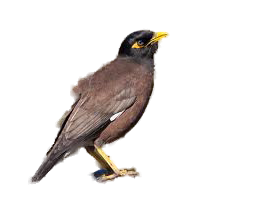Humane Disposal of Myna Birds
Handling and Disposal of Myna Birds is subject to regulations in each state.
Treatment
Always use gloves when handling
live or dead birds as wild birds may carry disease.
Any traps used are to be
designed specifically for Indian Mynas and to have a mechanism to allow immediate release of
any native birds.
The traps are to contain
food and clean water for any trapped birds.
The birds are not to be
exposed to undue stress while trapped.
Avoid manhandling or
approaching the traps too frequently.
Trapped Indian Mynas are to
be disposed of in a reasonable period (within two days), rather than kept captive for days on
end.
If decoy birds are used in
traps, they and any trapped birds are to have access to adequate food, clean water, shelter and
shade.
Traps are to be checked
morning and evening
The birds are not to be treated cruelly or
left in harsh conditions: please observe the requirements of the Animal Welfare Act
1992
Disposal
The method used for
doing away with trapped birds is to be
quick, painless, and
stress-free
Acceptable euthanising
methods in most Australian states include gassing with carbon dioxide or carbon
monoxide
(# which can be
produced by petrol car engine exhausts).
#
Rules & regulations are constantly changing. The NSW Department of
Primary
Industries have recently outlawed this practice in NSW suggesting the
exhausts can cause severe irritation before death. Please check with
your relevant state body if you require more information in this
regard.
If using carbon monoxide via engine exhaust, use a car with a
cold engine; do not use diesel vehicles.
Place the containment chamber with the trapped
birds in a near-airtight bag or box, connect a grey water hose / pipe from the car exhaust pipe into the bag / box and run the cold car for a minute or so. The birds should be unconscious within 10-15 seconds and dead within 30-40 seconds. If it takes longer than 30-40 seconds for the birds to die peacefully there is something wrong with your technique.
It is preferred that cervical dislocation
(breaking their necks) is not used, except by qualified professionals and then is to be
instantaneous, with minimal handling of the birds.
Dead birds are to be disposed of in a
hygienic and environmentally sound way
We stress that you should contact your
local council to check on rules and regulations for your area and/or the nearest
RSPCA for more details on disposal methods. Some branches of the RSPCA have agreed to
euthanize and dispose of trapped birds free of charge.
Not sure of the regulations in your area? Contact you local Indian Myna action group.
